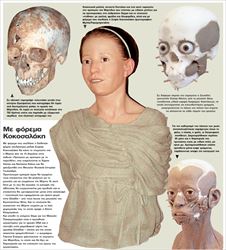Πολυτονιστής: γράψτε απευθείας αρχαία ελληνικά
Digital Research in the Study of Classical Antiquity
>> Δευτέρα 26 Απριλίου 2010
Digital Research in the Study of Classical Antiquity
This book explores the challenges and opportunities presented to Classical scholarship by digital practice and resources. Drawing on the expertise of a community of scholars who use innovative methods and technologies, it shows that traditionally rigorous scholarship is as central to digital research as it is to mainstream Classical Studies. The chapters in this edited collection cover many subjects, including text and data markup, data management, network analysis, pedagogical theory and the Social and Semantic Web, illustrating the range of methods that enrich the many facets of the study of the ancient world. This volume exemplifies the collaborative and interdisciplinary nature that is at the heart of Classical Studies.
Contents: Introduction, Simon Mahony and Gabriel Bodard; Part I Archaeology and Geography: Silchester Roman town: developing virtual research practice 1997–2008, Michael G. Fulford, Emma J. O'Riordan, Amanda Clarke and Michael Rains; Diversity and reuse of digital resources for ancient Mediterranean material culture, Sebastian Heath; Space as an artefact: a perspective on 'neogeography' from the digital humanities, Stuart Dunn. Part II Text and Language: Contextual epigraphy and XML: digital publication and its application to the study of inscribed funerary monuments, Charlotte Tupman; A virtual research environment for the study of documents and manuscripts, Alan K. Bowman, Charles V. Crowther, Ruth Kirkham and John Pybus. One era's nonsense, another's norm: diachronic study of Greek and the computer, Notis Toufexis. Part III Infrastructure and Disciplinary Issues: Digital infrastructure and the Homer multitext project, Neel Smith; Ktêma es aiei: digital permanence from an ancient perspective, Hugh A. Cayless; Creating a generative learning object (GLO): working in an 'ill-structured' environment and getting students to think, Eleanor O'Kell, Dejan Ljubojevic and Cary MacMahon; The digital classicist: disciplinary focus and interdisciplinary vision, Melissa Terras; Bibliography; Index.
About the Editor: Dr Gabriel Bodard is Research Associate at the Centre for Computing in the Humanities, KCL and Simon Mahony is at the University College London, UK
Reviews: 'A productive interdisciplinary collaboration among computer scientists, engineers, classicists, and other humanities researchers within an open community of scholars sharing complementary skills and interests ... Perusing the contents of this stimulating volume, a representative sampling of innovative projects that employ advanced digital technologies, one feels much as Da Gama must have felt gazing out across the vast, variegated landscape of a world as yet unexplored.'
John Bodel, Brown University, USA
'Where once scholars considered how to apply IT to the study of the ancient world, now we must consider how to place the study of the ancient world within 'digital knowledge'. This has required us to rethink the classifications, collaborations and alliances with which we have operated for so long, and to consider the new audiences (expert and inexpert) who will look at, and sometimes contribute to, our resources and scholarship. This volume reflects the achievements, the potential and the challenges of this situation. It brings together practitioners from a diverse range of specialisms within classics: epigraphy and papyrology, literary and linguistic study, archaeology, numismatics. Their contributions demonstrate progress in digitization, but beyond that, they explore the wider context (academic and technical) in which digital classics must now function'.
Elaine Matthews, University of Oxford, UK
Ενα κορίτσι της αρχαίας Αθήνας αποκαλύπτεται
>> Κυριακή 11 Απριλίου 2010
χρόνια μετά τον θάνατό της και δείχνει το πρόσωπό της για πρώτη φορά χάρη στη σύγχρονη τεχνολογία. Κυρίες και κύριοι η 11χρονη Μύρτις
Τα μαλλιά της είναι κοκκινωπά. Τα μάτια της καστανά. Τα δόντια της ελαφρώς πεταχτά. Η μύτη της ίσια. Τίποτα στο πρόσωπό της δεν μαρτυρά ότι έζησε και πέθανε πριν από 2.440 χρόνια.
Το όνομά της Μύρτις. Ενα απο τα πολλά θύματα του τυφοειδούς πυρετού που αφάνισε το ένα τρίτο του πληθυσμού της Αθήνας στο τέλος του 5ου αι. π.Χ. και μαζί τον σπουδαίο αθηναίο πολιτικό Περικλή. Ηταν μόλις 11 ετών όταν έχασε τη ζωή της και τάφηκε βιαστικά σε έναν ομαδικό τάφο μαζί με ακόμη 150 ανθρώπους. Το κρανίο της, που διατηρήθηκε σε άριστη κατάσταση, αποκαλύπτει το πρόσωπό της. Και γίνεται το πρώτο παιδί που ανακτά τη φυσιογνωμία του με τη βοήθεια της σύγχρονης τεχνολογίας, ενώ μας φέρνει πιο κοντά στην εικόνα των κατοίκων της αρχαίας Αθήνας. «Πρόκειται για ένα κορίτσι περίπου 11 ετών και το μόνο που μπορούμε να πούμε είναι ότι είχε ορθοδοντικό πρόβλημα: λόγω της συνύπαρξης παιδικών και μονίμων δοντιών δημιουργούνταν συνωστισμός στην άνω γνάθο και οι κυνόδοντες ήταν εκτός τόξου», λέει στα «ΝΕΑ» ο επίκουρος καθηγητής Ορθοδοντικής του Πανεπιστημίου Αθηνών Μανώλης Παπαγρηγοράκης, που είναι και η ψυχή της διεπιστημονικής ιδέας της ανασύστασης του προσώπου της Μύρτιδος, η οποία έγινε από όλους τους συντελεστές αφιλοκερδώς και παρουσιάστηκε χθες σε εκδήλωση στο Νέο Μουσείο Ακρόπολης. «Δεν μπορούμε να μιλήσουμε για κάτι χαρακτηριστικό που να τη διαφοροποιεί από ένα παιδί της ηλκίας του», εξηγεί.
Περισσότερα ΤΑ ΝΕΑ Read more...







